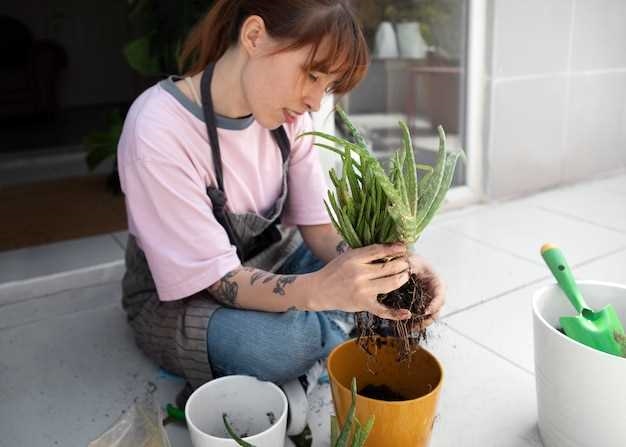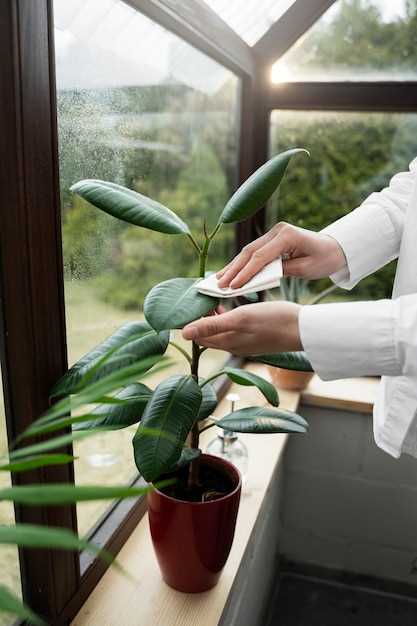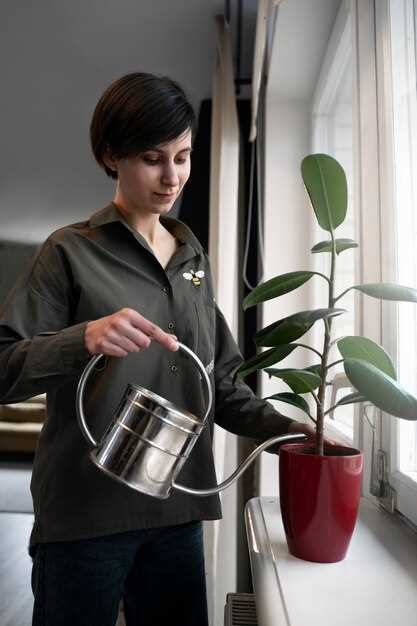

Discover the secrets to cultivating flourishing greenery and vibrant floral displays with our expert insights on the art of watering. In this comprehensive guide, we delve into the intricacies of proper hydration, offering invaluable strategies for maintaining the health and vitality of your beloved plants.
Unleash the Power of Precision: Achieving the perfect balance between underwatering and overwatering is a delicate dance that requires finesse. By understanding the specific needs of each plant species, you can tailor your watering routine to provide just the right amount of moisture, ensuring their optimal growth and development.
Timing is Everything: Timing plays a crucial role in the watering equation. As the sun rises and sets, the temperature and humidity levels fluctuate, influencing the water absorption rate of your plants. By scheduling your watering sessions during the cooler hours of the day, you can maximize the effectiveness of each watering session, allowing the roots to absorb the moisture more efficiently.
The Art of Observation: Developing a keen eye for the signs of dehydration or overhydration is an essential skill for any aspiring plant enthusiast. By closely monitoring the condition of your plants’ leaves, stems, and soil, you can identify early warning signs and adjust your watering regimen accordingly. Remember, each plant has its own unique language, and by listening attentively, you can provide the care they need to thrive.
Watering from the Roots: While it may be tempting to shower your plants from above, directing your attention to the roots is the key to unlocking their full potential. By watering directly at the base of the plant, you ensure that the water reaches the root system, where it is most needed. This targeted approach promotes stronger root development, leading to healthier plants and more vibrant blooms.
With these expert techniques at your disposal, you are now equipped to embark on a journey of nurturing and growth. By mastering the art of watering, you can create an oasis of lush greenery and breathtaking blossoms, transforming your space into a haven of natural beauty.
Understanding the Watering Needs of Different Plants
When it comes to watering plants, it is crucial to understand that each type of plant has its own unique requirements. Properly meeting these watering needs is essential for their overall health and vitality. By gaining a deeper understanding of the specific watering needs of different plants, you can ensure that they receive the right amount of water at the right time, promoting optimal growth and vibrant blooms.
Identifying Plant Types and Their Watering Preferences
One of the first steps in understanding the watering needs of different plants is to identify their specific types. Whether you have succulents, tropical plants, or flowering perennials, each category has distinct characteristics that influence their water requirements. Some plants, like cacti, thrive in arid conditions and prefer infrequent watering, while others, such as ferns, thrive in moist environments and require more frequent watering.
Factors Influencing Watering Frequency
Several factors can influence the frequency at which plants need to be watered. These include the plant’s natural habitat, its stage of growth, the season, and the type of soil it is planted in. For example, plants native to desert regions have adapted to survive in dry conditions and may require less water compared to plants native to rainforests. Similarly, young plants and those in active growth stages generally require more water than mature plants or those in dormancy.
Understanding the watering needs of different plants is crucial for maintaining their health and promoting vibrant blooms. By identifying plant types and considering factors that influence watering frequency, you can provide the optimal amount of water for each plant, ensuring their overall well-being and beauty.
The Importance of Consistency in Watering
Ensuring consistent watering practices is crucial for the overall health and vitality of your plants and flowers. Consistency in watering refers to maintaining a regular and balanced watering schedule, providing your plants with the right amount of water at the right time. This practice helps establish a stable environment for your plants, allowing them to thrive and produce vibrant blooms.
1. Optimal Growth Conditions
Consistent watering creates optimal growth conditions for your plants. By providing a steady supply of water, you help maintain the moisture levels in the soil, which is essential for root development and nutrient absorption. When plants receive consistent watering, they can establish a strong root system, enabling them to access water and nutrients efficiently.
2. Preventing Stress and Diseases
Inconsistent watering can lead to stress and diseases in plants. When plants are subjected to irregular watering, they may experience periods of drought or excessive moisture, both of which can weaken their immune system and make them more susceptible to diseases and pests. Consistent watering helps prevent these fluctuations, keeping your plants healthy and resilient.
- Water your plants at the same time each day, preferably in the morning or evening when temperatures are cooler.
- Monitor the moisture levels in the soil regularly to ensure it remains consistently moist, but not waterlogged.
- Adjust your watering schedule based on weather conditions, taking into account rainfall and humidity levels.
- Use mulch to help retain moisture in the soil and reduce evaporation.
By following these tips and maintaining consistency in your watering routine, you can provide your plants with the ideal conditions for growth, resulting in healthy plants and vibrant blooms.
Choosing the Right Time of Day to Water

Optimizing the timing of watering can significantly impact the health and vitality of your plants and the vibrancy of their blooms. By carefully selecting the appropriate time of day to water, you can ensure that your plants receive the necessary hydration without risking excessive moisture or potential damage.
One crucial factor to consider when determining the ideal time to water is the temperature. It is generally recommended to avoid watering during the hottest parts of the day, as the intense heat can cause water to evaporate quickly, resulting in inadequate hydration for your plants. Additionally, watering during peak temperatures can increase the risk of scorching the leaves and flowers, especially for more delicate plant varieties.
Instead, it is advisable to water your plants in the early morning or late afternoon when the temperatures are cooler. During these times, the soil has had a chance to cool down overnight or throughout the day, allowing the water to penetrate deeply into the root zone. This deep watering promotes stronger root growth and enhances the overall resilience of your plants.
Furthermore, watering in the early morning or late afternoon helps to minimize the risk of fungal diseases. By avoiding watering in the evening, you can prevent excess moisture from lingering on the leaves and flowers overnight, which can create a favorable environment for fungal growth. Adequate airflow and sunlight during the day can help dry out the foliage, reducing the chances of fungal infections.
It is worth noting that different plants have varying water requirements, and factors such as soil type, climate, and plant maturity should also be considered when determining the best time to water. Observing your plants closely and monitoring the moisture levels in the soil can help you fine-tune your watering schedule to meet their specific needs.
In conclusion, choosing the right time of day to water your plants is a crucial aspect of proper watering practices. By watering during the cooler parts of the day, you can ensure efficient water absorption, minimize the risk of heat damage and fungal diseases, and promote the overall health and vibrancy of your plants and blooms.
Watering Techniques for Different Types of Soil
When it comes to watering your plants, it’s important to consider the type of soil you have. Different types of soil have different water-holding capacities and drainage abilities, which can greatly affect the watering needs of your plants. By understanding the characteristics of your soil, you can develop effective watering techniques that will promote healthy growth and vibrant blooms.
1. Sandy Soil:
- Due to its coarse texture, sandy soil drains quickly, making it prone to dryness.
- Watering techniques for sandy soil should focus on frequent, light watering to ensure that the water penetrates deep into the root zone.
- Consider using a drip irrigation system or a soaker hose to deliver water directly to the roots.
- Adding organic matter, such as compost or peat moss, can help improve the water-holding capacity of sandy soil.
2. Clay Soil:
- Clay soil has a high water-holding capacity but drains poorly, leading to waterlogged conditions.
- Watering techniques for clay soil should aim for deep, infrequent watering to allow the water to penetrate and reach the roots.
- Avoid overwatering, as it can lead to root rot and other plant diseases.
- Consider using raised beds or containers with well-draining soil to provide better drainage for plants that don’t tolerate wet conditions.
3. Loamy Soil:
- Loamy soil is considered the ideal soil type for gardening, as it has a balanced water-holding capacity and good drainage.
- Watering techniques for loamy soil should focus on maintaining consistent moisture levels by watering deeply and evenly.
- Monitor the soil moisture regularly and adjust the watering frequency based on the specific needs of your plants.
- Applying a layer of organic mulch can help retain moisture and regulate soil temperature.
4. Sandy Loam or Silty Soil:
- Sandy loam or silty soil is a combination of sandy and loamy soil, offering good drainage and moderate water-holding capacity.
- Watering techniques for sandy loam or silty soil should aim for a balance between deep watering and frequent watering.
- Monitor the soil moisture levels and adjust the watering schedule accordingly to prevent under or overwatering.
- Consider using a moisture meter to accurately determine the moisture content of the soil.
Remember, understanding the characteristics of your soil and tailoring your watering techniques accordingly is essential for the overall health and vitality of your plants. By providing the right amount of water at the right time, you can ensure that your plants thrive and produce vibrant blooms.
Avoiding Common Mistakes in Watering
Ensuring the health and vibrancy of your plants and blooms requires proper watering techniques. However, many gardeners unknowingly make mistakes that can negatively impact their plants. By understanding and avoiding these common errors, you can optimize your watering routine and promote the optimal growth of your beloved greenery.
1. Overwatering: One of the most prevalent mistakes gardeners make is overwatering their plants. While it may seem like providing more water is beneficial, excessive moisture can lead to root rot and other fungal diseases. It is essential to strike a balance and only water when necessary.
2. Underwatering: On the other hand, underwatering is equally detrimental to the health of your plants. Insufficient water supply can cause wilting, stunted growth, and even death. It is crucial to monitor the moisture levels in the soil and provide adequate hydration to your plants.
3. Incorrect watering schedule: Establishing a consistent watering schedule is crucial for plant health. Watering too frequently or irregularly can disrupt the plant’s natural growth cycle and make it more susceptible to stress and diseases. Understanding the specific water requirements of each plant species in your garden is essential for creating an appropriate watering routine.
4. Improper watering technique: The way you water your plants can also impact their overall health. Avoid watering the foliage excessively, as this can lead to the development of fungal diseases. Instead, focus on watering the soil directly at the base of the plant to ensure the roots receive adequate moisture.
5. Ignoring environmental factors: Environmental conditions play a significant role in determining the watering needs of your plants. Factors such as temperature, humidity, and sunlight exposure can affect the rate at which plants lose moisture. It is essential to consider these factors and adjust your watering routine accordingly.
6. Neglecting drainage: Proper drainage is crucial for preventing waterlogged soil and root rot. Ensure that your pots and containers have drainage holes to allow excess water to escape. Additionally, consider using well-draining soil mixes to promote healthy root development.
7. Not observing plant signals: Plants often provide visible signs when they are in need of water. Wilting, yellowing leaves, and drooping stems are common indicators of dehydration. Pay attention to these signals and adjust your watering routine accordingly to prevent further damage.
By avoiding these common mistakes and adopting proper watering practices, you can provide your plants with the ideal conditions for growth and ensure their long-term health and vitality.
Using Technology to Enhance Watering Efficiency
Advancements in technology have revolutionized various aspects of our lives, and the world of gardening is no exception. By harnessing the power of technology, gardeners can optimize their watering practices to ensure healthier plants and more vibrant blooms. This section explores the various ways in which technology can be utilized to enhance watering efficiency.
1. Smart Irrigation Systems
One of the most effective ways to optimize watering efficiency is by utilizing smart irrigation systems. These systems use sensors and weather data to determine the precise watering needs of plants. By monitoring factors such as soil moisture levels, temperature, and rainfall, smart irrigation systems can automatically adjust watering schedules and deliver the right amount of water at the right time. This not only prevents overwatering but also ensures that plants receive adequate hydration.
2. Moisture Sensors
Moisture sensors are another valuable tool for optimizing watering efficiency. These sensors are inserted into the soil and measure the moisture content at various depths. By providing real-time data on soil moisture levels, gardeners can accurately determine when and how much to water their plants. This helps prevent under or overwatering, as plants can suffer from both conditions. Moisture sensors enable gardeners to make informed decisions and ensure that plants receive the optimal amount of water.
3. Drip Irrigation Systems
Drip irrigation systems are a popular choice for gardeners looking to maximize watering efficiency. These systems deliver water directly to the plant’s root zone, minimizing water loss due to evaporation or runoff. By providing a slow and steady supply of water, drip irrigation systems ensure that plants receive a consistent amount of moisture without wasting water. Additionally, drip irrigation systems can be easily automated and integrated with smart technology, further enhancing their efficiency.
4. Weather Apps and Forecasting Tools

Weather apps and forecasting tools can be invaluable resources for gardeners seeking to optimize watering efficiency. By staying informed about upcoming weather conditions, gardeners can adjust their watering schedules accordingly. For example, if rain is forecasted, they can delay watering to avoid unnecessary moisture. Similarly, during hot and dry periods, they can increase watering frequency to compensate for increased evaporation. By utilizing weather apps and forecasting tools, gardeners can make informed decisions and adapt their watering practices to the specific needs of their plants.
- Smart irrigation systems
- Moisture sensors
- Drip irrigation systems
- Weather apps and forecasting tools
By embracing technology and incorporating these innovative tools into their gardening routines, individuals can optimize watering efficiency, conserve water resources, and promote the health and vitality of their plants.




